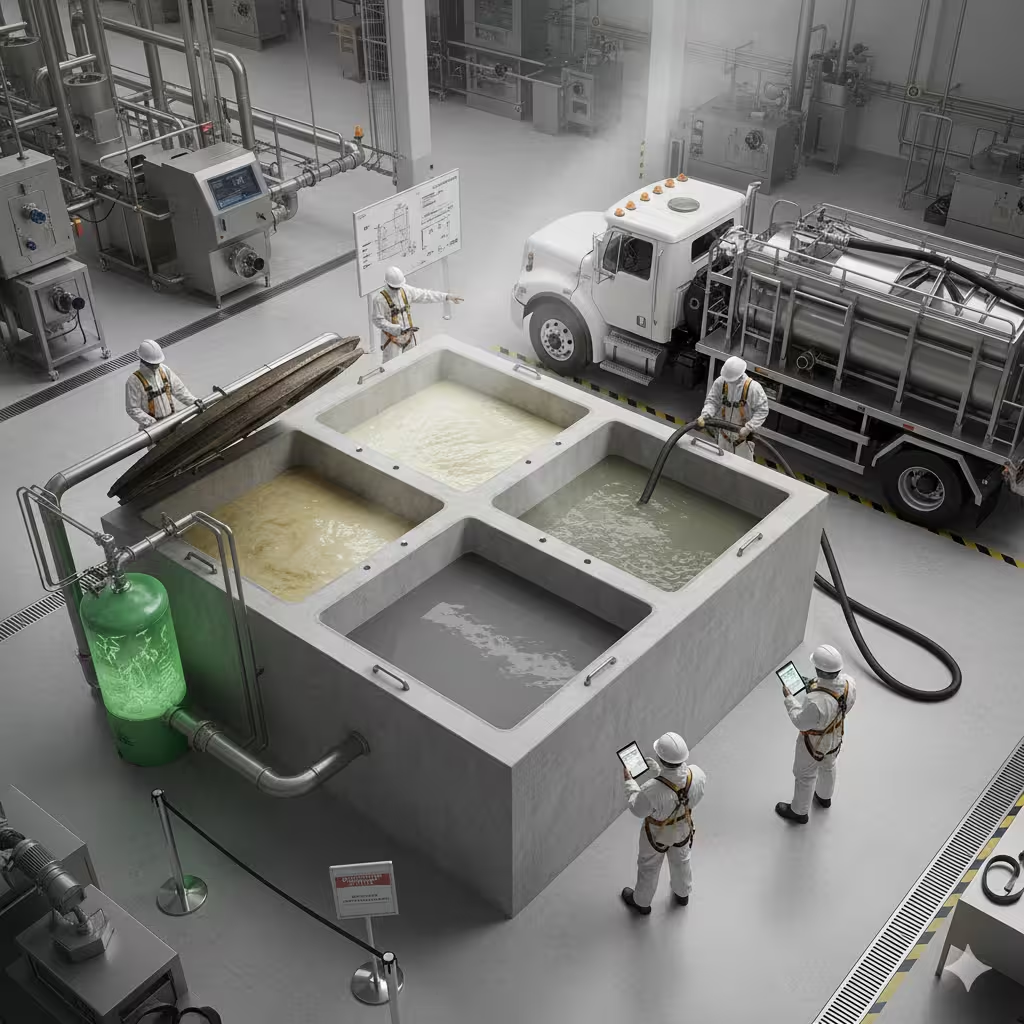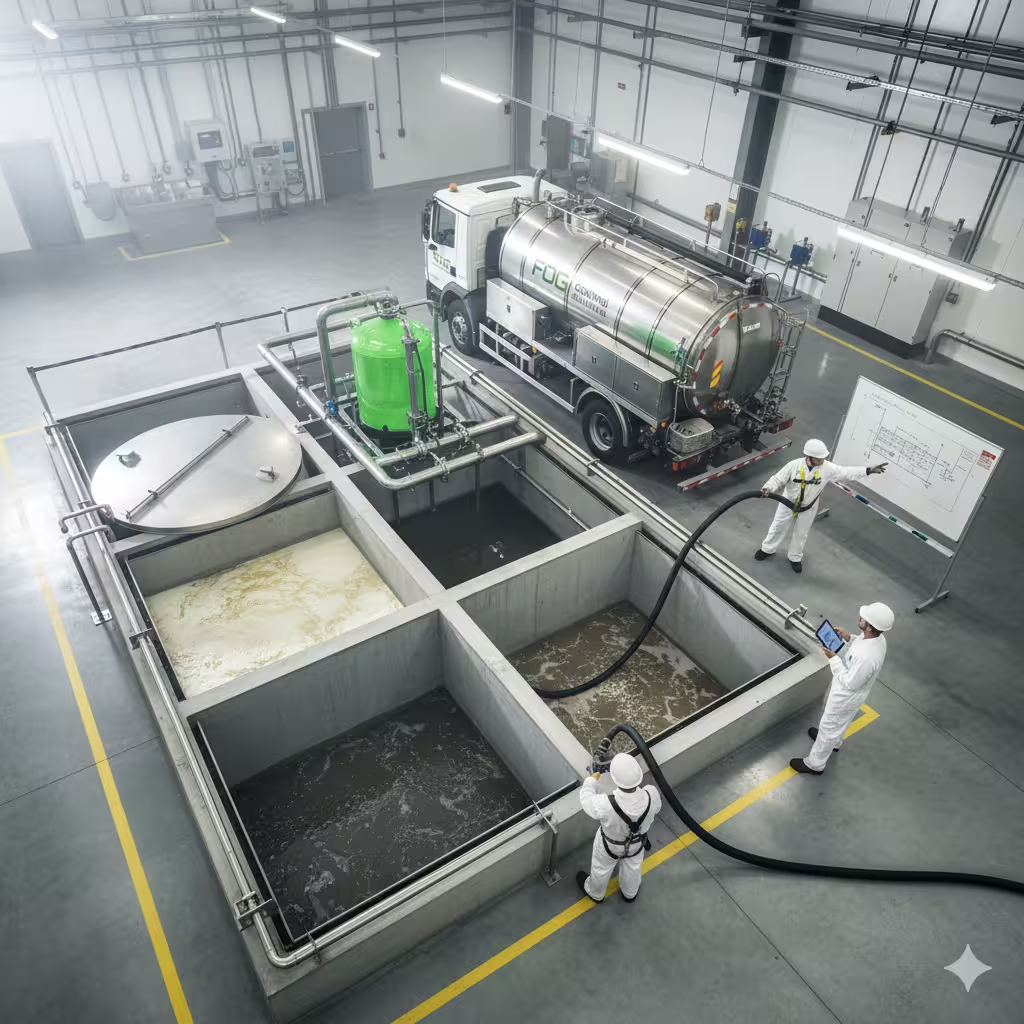For large-scale food manufacturers, industrial commissaries, and high-volume processing plants, FOG (Fats, Oils, and Grease) management is an engineering challenge. The backbone of this operation is the Industrial Grease Trap—a system far more complex than the small traps found under a restaurant sink.
A properly sized and meticulously maintained Industrial Grease Trap system is non-negotiable for operational integrity and regulatory compliance. This guide provides an in-depth look at the science of sizing, the requirements for maintenance, and the best practices for controlling the heavy FOG loads generated by industrial facilities.
1. Understanding the Industrial Grease Trap: Interceptors vs. Traps
The terms “grease trap” and “grease interceptor” are often used interchangeably, but in the industrial sector, the distinction is crucial. When we refer to an Industrial Grease Trap, we are almost always talking about a Gravity Grease Interceptor (GGI).
Gravity Grease Interceptors (GGIs)
These are large, in-ground units—often concrete, fiberglass, or steel tanks—designed to handle massive volumes of wastewater and FOG.
- Capacity: Typically 750 gallons up to several thousand gallons.
- Mechanism: GGIs rely on retention time and gravity. Wastewater is held for a sufficient period (often 20 minutes or more) to allow FOG (which is lighter than water) to float to the surface and solids (which are heavier) to sink to the bottom.
- Best for: Industrial bakeries, meatpacking plants, centralized food production facilities, and any establishment generating high flow rates and high FOG/solids concentrations.
An appropriately sized Industrial Grease Trap ensures that water velocity is slow enough to facilitate effective separation before effluent is discharged into the municipal sewer system.
2. The Critical Science of Industrial Grease Trap Sizing
The calculation for sizing an Industrial Grease Trap is far more involved than simply counting sinks. An undersized interceptor will lead to rapid FOG accumulation, inefficient separation, and guaranteed non-compliance. Sizing is governed by local plumbing codes and engineered calculations that account for flow rate, fixture units, and retention time.
Key Sizing Methods
While specific formulas vary by municipality (Uniform Plumbing Code, International Plumbing Code, etc.), the principle remains the same: calculating the required liquid capacity based on the wastewater output.
A. The Fixture Unit Method (Common for Smaller Commercial)
This method assigns a numerical fixture unit (FU) value to every connected drain line or fixture (e.g., floor drains, sinks, pre-rinse stations).
- Calculate Total FUs: Sum the fixture units for all connected equipment.
- Determine Flow Rate (GPM): The total FU count is multiplied by a defined flow rate (often 3 GPM per FU) to determine the minimum required flow rating of the Industrial Grease Trap.
B. The Peak Flow Rate & Retention Time Method (Essential for Industrial)
For large industrial users, a more rigorous calculation is necessary. This method focuses on the maximum volume of water discharged during a peak operating hour.
$$\text{Size Requirement (Liquid Capacity)} = N \times \text{WF} \times \text{RT} \times \text{SF}$$
- $N$: Number of meals served at peak hour (for commissaries) or total flow rate (in gallons per hour).
- $\text{WF}$: Waste Flow Rate (e.g., 2 gallons per meal).
- $\text{RT}$: Retention Time (e.g., $2.5 \text{ hours}$ for commercial kitchen waste).
- $\text{SF}$: Storage Factor (varies by facility type, e.g., $1.0$ for fast food, $1.25$ for restaurants).
Crucial Considerations for Industrial Sizing:
- High-Temperature Discharge: Wastewater from industrial dishwashers or steam kettles is often too hot. Water must cool to less than $120^\circ\text{F}$ before entering the Industrial Grease Trap to allow FOG to solidify. Failure to do so requires a large separation distance or a cooling tank.
- Solids Load: Industrial facilities often produce high solids (slurry, vegetable scraps, etc.). The Industrial Grease Trap must be sized to accommodate both FOG and a substantial amount of settled solids (sludge).
- Consultation: Due to the complexity of these factors, an Industrial Grease Trap design must be certified and sealed by a Registered Professional Engineer to ensure compliance with local regulations.

3. Best Practices for Industrial Grease Trap Maintenance
Maintenance is where most facilities fail. An Industrial Grease Trap that is not serviced frequently enough will fail, leading to blockages, backups, and steep non-compliance fines.
A. The 25% Rule: Your Guiding Principle
The industry standard, mandated by most municipal FOG ordinances, is the 25% Rule:
An Industrial Grease Trap must be fully pumped out when the accumulated layer of floating FOG and the settled layer of solids (sludge) collectively occupy 25% or more of the trap’s total liquid capacity.
For high-volume industrial operations, this often means a mandatory pump-out frequency of 30 to 90 days. Facilities must establish a rigorous inspection schedule to monitor this layer depth.
B. Prohibited Practices: What to Never Do
To maintain the efficiency of your Industrial Grease Trap and comply with regulations, avoid these common mistakes:
- Chemical Additives: Never use degreasers, acids, solvents, or emulsifying agents. These products temporarily liquefy the FOG, causing it to bypass the interceptor baffles and re-solidify further downstream in the public sewer, which is a major violation.
- Hot Water Flushing: Using hot water to push FOG down the drain only delays the problem, guaranteeing a costly blockage later.
C. The Power of Biological Treatment
The most effective maintenance strategy, in conjunction with regular pump-outs, is the use of plant-based biological treatments.
- These treatments introduce specialized, non-toxic bacteria and enzymes into the system.
- The microbes actively digest the FOG, breaking it down into harmless, water-soluble compounds like $\text{CO}_2$ and water.
- This significantly reduces the rate of FOG accumulation, helping to keep the Industrial Grease Trap cleaner between professional service cycles and mitigating foul odors.
This proactive, eco-friendly approach is a key component of modern, sustainable Industrial Grease Trap management.
4. Compliance, Safety, and Documentation
Compliance is not just about cleaning; it’s about providing verifiable proof of proper maintenance to the regulatory authority.
Record Keeping and Manifests
Every service call for your Industrial Grease Trap requires a paper or digital waste manifest from the licensed waste hauler. This document is proof that the FOG waste was removed and disposed of legally.
- Retention: Most jurisdictions require facilities to retain these manifests on-site for a minimum of three to five years.
- Inspections: Municipal inspectors will request to see these manifests to verify that your Industrial Grease Trap is being serviced at the proper frequency.
Safety Protocols (OSHA Considerations)
Given the size of an Industrial Grease Trap, safety is paramount:
- Confined Space Entry: Large, in-ground interceptors may be classified as Permit-Required Confined Spaces if they are large enough for bodily entry. Entry requires specialized training, ventilation, and atmospheric monitoring due to the potential presence of toxic gases ($\text{H}_2\text{S}$) and low oxygen.
- Secure Covers: All Industrial Grease Trap covers must be heavy-duty, properly seated, and secured to prevent accidental displacement and worker injury.
5. Frequently Asked Questions (FAQ)
Q1: Is my large capacity grease trap classified as a confined space?
A: If the Industrial Grease Trap is large enough for a worker to enter and perform tasks, it is highly likely to be considered a confined space under OSHA regulations. Only licensed professionals with proper training and monitoring equipment should ever enter an interceptor.
Q2: What is the most common reason an industrial grease trap fails?
A: The most common reason for Industrial Grease Trap failure is infrequent pumping (not adhering to the 25% Rule) combined with poor source control (allowing excessive solids and grease into the drain).
Q3: Can I use biological additives instead of pumping the Industrial Grease Trap?
A: No. Biological additives are a powerful tool for enhancing performance and extending the time between cleanings, but they do not eliminate the regulatory requirement for professional pump-outs. Solids and residual non-digestible FOG still accumulate and must be removed.
Q4: How far must a dishwasher be from an Industrial Grease Trap?
A: Many codes require the Industrial Grease Trap to be installed at a minimum distance (e.g., 10 feet) from high-heat sources like commercial dishwashers to allow the wastewater to cool below $120^\circ\text{F}$. If distance isn’t feasible, a dedicated cooling chamber may be required.
Conclusion: Partnering for Reliable Industrial FOG Control
Managing an Industrial Grease Trap requires precision engineering, proactive maintenance planning, and dedicated adherence to FOG regulations. When done correctly, it ensures uninterrupted operations, minimizes maintenance costs, and safeguards your compliance status.
If you are struggling with frequent blockages, odor issues, or the complexity of large-scale Industrial Grease Trap maintenance, don’t leave your operations at risk. FOG Control Solutions is a reliable and trusted provider specializing in the audit, sizing, and long-term biological maintenance programs for large Industrial Grease Trap systems.
✅ Ensure your Industrial Grease Trap is compliant and running efficiently.
Contact FOG Control Solutions today to schedule a professional assessment and implement a tailored FOG management plan that integrates advanced plant-based solutions to protect your plumbing and your business.

